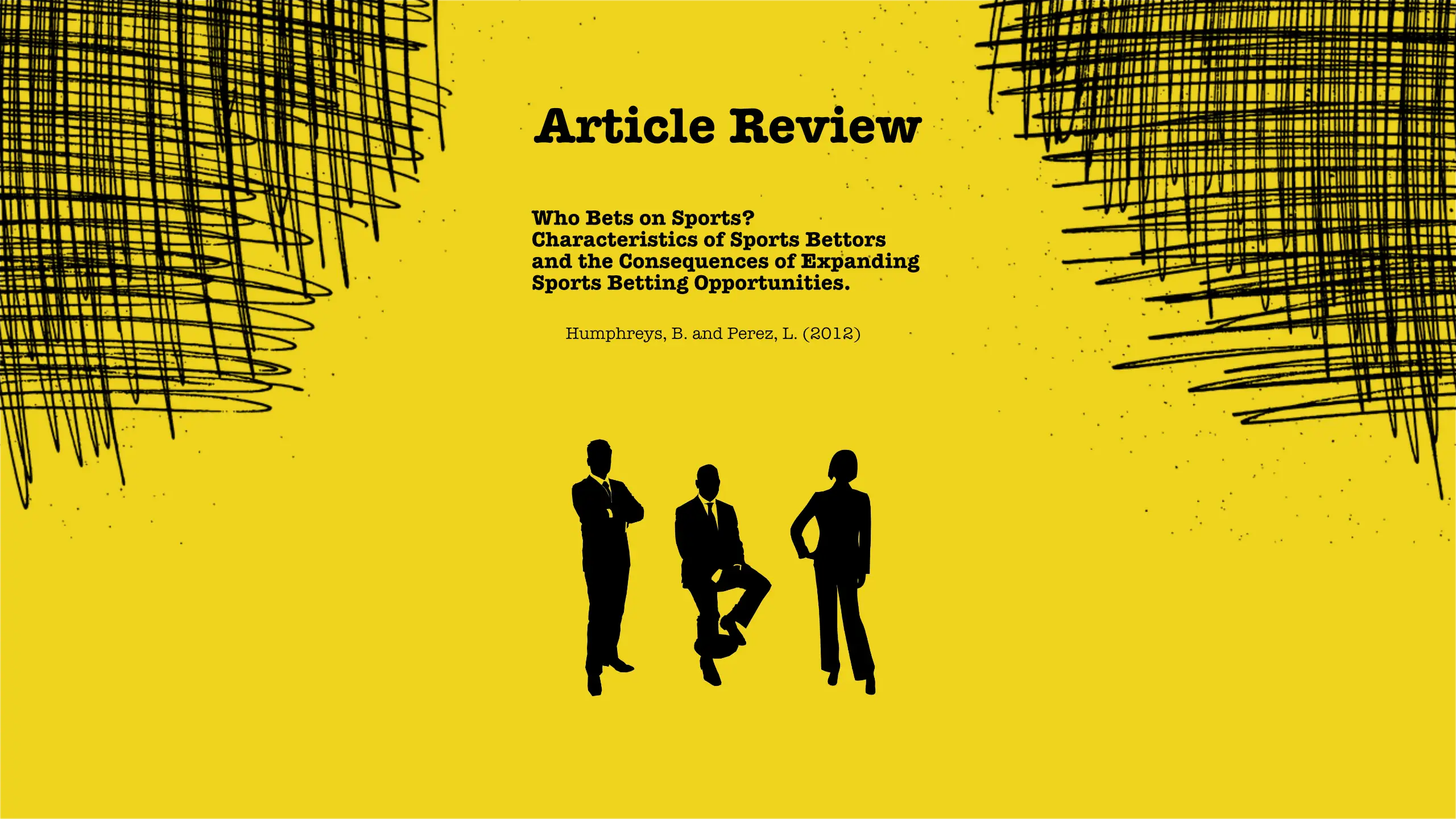Who bets on sports? — almost everyone, but young men with higher income dominate the field.
This demographic profile, remarkably similar to that of sports fans, highlights the natural connection between spectatorship and sports betting.
In Who Bets on Sports? Characteristics of Sports Bettors and the Consequences of Expanding Sports Betting Opportunities (Humphreys & Pérez, 2012), the authors compare three national betting markets — Canada, Spain, and the United Kingdom — to examine how regulatory frameworks shape participation, market outcomes, and socio-economic implications.
Key Concepts
1. Who are sports bettors?
Sports bettors, across contexts, tend to be:
- Male,
- Employed,
- Not single, and
- Earning relatively high incomes.
These individuals also exhibit a strong overlap with sports spectators, suggesting that betting complements fandom.
As noted by the authors, the likelihood of betting decreases with age but increases with income — consistent with prior studies on sports consumption (Hammervold & Solberg, 2006; Borland & Macdonald, 2003).
“The likelihood that an individual bets on sports falls with age. The likelihood that an individual bets on sports increases with income.”
2. Market comparison: Canada, Spain, and the UK
The paper examines sports gambling markets under different regulatory systems:
| Country | Market Type | Education Level of Bettors | Regulation Context |
|---|---|---|---|
| Canada | State monopoly | Higher education levels | Government-controlled |
| Spain | State monopoly (at the time) | Higher education levels | Liberalization began in 2011 |
| United Kingdom | Private and competitive | Lower education levels (non-college) | Fully privatized and liberalized |
The findings reveal an intriguing pattern:
State monopolies attract more educated participants, while private markets (such as the UK’s) attract a broader population, including less-educated bettors.
This difference may stem from odds competitiveness and return-to-player (RTP) rates — where competition among private operators improves payouts, making betting more appealing to a wider audience.
3. Market economics: overround and return-to-player
The article introduces two key financial terms that describe the economics of betting systems:
- Overround: the proportion of money retained by the bookmaker (the opposite of RTP).
- Return-to-Player (RTP): the percentage of total stakes returned to bettors as winnings.
In state-monopoly markets, overrounds tend to be high — between 160% and 300% — meaning bettors lose more to the operator.
In competitive private markets, overrounds fall to about 110%, reflecting better odds due to market competition.
Spain’s La Quiniela, for instance, had a takeout rate of 45%, meaning nearly half of all stakes were retained by the state.
These structural differences underscore how market competition improves consumer outcomes, while monopolies emphasize revenue collection.
4. The paradox of government revenue
Governments face a dual dilemma:
- On one hand, they recognize the social and ethical issues surrounding gambling.
- On the other, they benefit financially from taxation, overrounds, and licensing.
In state-controlled markets like Spain and Canada, revenues from betting monopolies are directed toward public programs and organizations.
By contrast, private markets like the UK rely on tax-based revenues from competing operators.
Interestingly, because higher-income individuals are more likely to participate, sports betting can act as a “progressive voluntary tax” — redistributing wealth through choice rather than obligation.
“Governments acknowledge problems and yet utilize sports gambling for revenue generation in the form of regulations and taxation.”
5. Social and economic side effects
The authors note several unintended consequences of expanding betting markets:
- Corruption risks in sports, especially when athletes or officials face betting-related incentives.
- Market liberalization (as in the EU) increasing the number of private operators and competition for consumer attention.
- Threats to public organizations previously funded by state-run betting monopolies, which lose financial support after privatization.
In Spain, syndicate betting groups emerged as players collaborated to pool funds and knowledge — an early form of collective intelligence in gambling.
6. Public choice theory and policy implications
The study draws from the Public Choice Model, which explains how government decisions are influenced by interest-group lobbying rather than pure public welfare.
This framework suggests that both regulators and industry actors negotiate policies balancing:
- Revenue generation,
- Consumer protection, and
- Market competition.
The gradual decline of state monopolies in the EU reflects this ongoing negotiation — seeking a balance between market efficiency and social responsibility.
Summary of Findings
| Aspect | State Monopoly (Spain, Canada) | Private Market (UK) |
|---|---|---|
| Regulation | Centralized | Competitive |
| Education of bettors | Higher | Lower |
| Overround | 160–300% | 110% |
| Funding flow | Direct to government programs | Via taxes |
| Market motivation | Revenue preservation | Consumer attraction |
| Risk | Lower variety, less innovation | Higher engagement, higher exposure |
Implications and Future Research
The findings raise key questions for policymakers and economists:
- How does market competition influence problem gambling rates?
- Can lower overrounds and better odds indirectly promote greater spending among bettors?
- What mechanisms can ensure social funding continuity after market liberalization?
Future research should explore how player behavior, education, and income distribution evolve as more governments shift toward regulated private markets.
Academic Reference
Humphreys, B., & Pérez, L. (2012). Who Bets on Sports? Characteristics of Sports Bettors and the Consequences of Expanding Sports Betting Opportunities. Estudios de Economía Aplicada, 30, 579–598.
External References
- Borland, J., & Macdonald, R. (2003). Demand for Sport. Oxford Review of Economic Policy, 19, 478–502.
- Hammervold, R., & Solberg, H. (2006). TV Sports Programs—Who is Willing to Pay to Watch? Journal of Media Economics, 19, 147–162.
